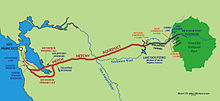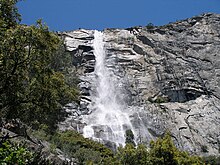Hetch Hetchy Valley
| Hetch Hetchy Valley | ||
|---|---|---|
|
Hetch Hetchy Valley, early 20th century |
||
| location | California (USA) | |
| Waters | Tuolumne River | |
| Mountains | Sierra Nevada | |
| Geographical location | 37 ° 56 ′ 51 ″ N , 119 ° 47 ′ 13 ″ W | |
|
|
||
The Hetch Hetchy Valley is the valley of the upper reaches of the Tuolumne River on the western flank of the Sierra Nevada in the US state of California . It is located in the northwestern part of Yosemite National Park , about 200 miles east of San Francisco . The valley was like the south-adjacent-known Yosemite -Tal of the Merced River in the Ice Age Aging of glaciers as a U-shaped valley formed and was for thousands of years by indigenous peoples ( Native Americans ) inhabited before the first Europeans reached the region in the 1850s. In the late 19th century, the valley was often compared to the Yosemite Valley for its natural beauty - but also interesting for the development of water supplies.
Hetch Hetchy Project
After the great earthquake in San Francisco in 1906 , in the wake of which devastating fires devastated the city, the lack of an adequate water supply became clear. The city turned to the United States Department of the Interior for water rights on Hetch Hetchy. In 1908, then Home Secretary James R. Garfield approved the rights to use the Tuolumne River. The Hetch Hetchy Project planned to build a dam at the narrowest point of the valley to damm the river. This sparked a seven-year dispute with the Sierra Club environmental movement , the most prominent representative of which was John Muir .
Since the valley lies within Yosemite National Park , the United States Congress had to approve the project. He did this on the condition that the water and the use of hydropower should only be accessible to the public. President Woodrow Wilson signed the Raker Act in 1913. Planning and preparations (including the construction of a 109-kilometer-long supply rail line) began in 1914.
Michael O'Shaughnessy , a civil engineer of Irish origin, planned and carried out the construction (1919–1923) of the O'Shaughnessy Dam, which was later named after him . The reservoir was flooded for the first time in May 1923. At that time, the arch weight wall was 69 meters high. The dam did not get its current height of 95 meters until 1938. Twenty years after planning began, in 1934, 20,000 people gathered in San Francisco to celebrate the arrival of the first water from Hetch Hetchy . The aqueduct that leads the water to the west coast is about 270 kilometers long and can transport about 10.4 m 3 / s of water.
About 80 percent of the population of San Francisco and the Bay Area (2.6 million people) are supplied with water from the Hetch Hetchy Valley . The water is some of the cleanest drinking water in the United States. This makes San Francisco one of only six cities in the United States not required by law to filter their water. Nevertheless, the water is disinfected with ozone and has also been irradiated with UV light since 2011 .
Conservationists see the project as one of the great environmental damage of the 20th century and are aiming to deconstruct it to restore the valley that was once famous for its beauty.
Individual evidence
- ^ The Hetch Hetchy Story, Part I
- ↑ The Hetch Hetchy Story, Part II (Eng.)
- ^ Page of the Tuolumne County Historical Society (English)
- ↑ Video about the idea of dismantling Hetch Hetchy (English)
- ^ Science, Oct. 27, 2006: 582-584. [DOI: 10.1126 / science.314.5799.582]
Publications by Michael Maurice O'Shaughnessy (1864–1934)
- The Hetch Hetchy water supply of San Francisco report of MM O'Shaughnessy, city engineer, to the Mayor, the Board of Public Works and the Board of Supervisors of San Francisco. Publisher: The Bureau of Engineering San Francisco Published 1916
- R ecommendation of MM O'Shaughnessy, City Engineer, on refuse incinerator: pursuant to resolution no.31,004, new series, of the Board of Supervisors, adopted June 10, 1929, and approved June 13, 1929 . Publisher: The Bureau of Engineering San Francisco Published 1929
- Hetch Hetchy water supply . Bureau of Engineering of the Department of Public Works, City and County of San Francisco, California. Publisher: James H. Barry Co. San Francisco, Calif. Published 1925
- The Hetch Hetchy water supply and power project of San Francisco . Published 1931
- Hetch Hetchy project . Published 1931
- Hetch hetchy; its origin and history . Published 1934





